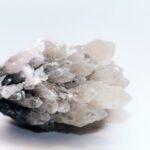Gemstone formation and composition are mesmerizing aspects of the natural world, filled with mystery and wonder. Have you ever wondered how these exquisite gems come into existence, or what gives them their distinctive colors and properties? In this article, we will embark on an enlightening journey into the captivating realm of gemstone formation and composition. Delving deep into the geological processes and intricate chemical interactions, we will unveil the secrets behind these dazzling treasures. So sit back, prepare to be amazed, and join us as we unravel the fascinating story of how gemstones are formed and what makes them truly remarkable.

Gemstone Formation and Composition
Gemstones are not only beautiful and captivating, but they also hold within them the secrets of the Earth’s geological history. The formation and composition of these precious stones involve a complex interplay of geological forces, creating a mesmerizing array of colors, textures, and properties. In this article, we will embark on a journey to unravel the fascinating world of gemstone formation and composition.
The Marvelous Processes of Gemstone Formation
Gemstones can form through four main processes: igneous, hydrothermal, metamorphic, and sedimentary. Each process contributes to the unique characteristics and properties of the gemstones we admire. Let’s delve into each process to better understand how these natural treasures come to be.
Igneous Process: Diamonds, Rubies, Sapphires, and Peridots
Imagine the extreme depths of the Earth’s mantle, where temperatures soar to unimaginable heights. It is in this fiery realm that gemstones such as diamonds, rubies, sapphires, and peridots are born. Through the igneous process, these gemstones crystallize from molten rock called magma, which solidifies deep within the Earth’s crust.
Diamonds, known for their dazzling beauty and exceptional hardness, form under immense pressure and intense heat. The carbon atoms arrange themselves in a unique crystal lattice structure, resulting in the brilliant gem we cherish. Rubies and sapphires, on the other hand, owe their vibrant colors to the presence of impurities within the crystal lattice. And peridots, with their striking green hues, emerge when the right combination of magnesium, iron, and silica come together.
The igneous process takes us on a journey to the depths of the Earth, where the birth of diamonds, rubies, sapphires, and peridots occurs. It is within this fiery crucible that the magic of gemstone formation unfolds.
Hydrothermal Process: When Water and Minerals Dance
Have you ever marveled at the formation of rock candy? The hydrothermal process works in a similar way, where gemstones are created when mineral-rich fluids seep through the Earth’s crust and cool. This mesmerizing dance between water and minerals gives birth to gemstones of exceptional beauty, such as aquamarines, topazes, and amethysts.
As the hot mineral-rich fluids rise towards the surface, they encounter cooler temperatures, causing the dissolved minerals to crystallize. This process can take hundreds, if not thousands, of years, as gemstones slowly grow within cracks and cavities.
Just like the formation of rock candy, the hydrothermal process crafts gemstones in a delicate interplay between mineral-rich water and the Earth’s natural cooling forces.
Metamorphic Process: The Transformative Power of Heat and Pressure
Under intense heat and extreme pressure, gemstones can undergo a remarkable transformation through the metamorphic process. This process occurs deep within the Earth’s crust, where tectonic forces collide and rock layers fold and buckle.
During metamorphism, existing minerals undergo profound changes as they are exposed to heat and pressure. Through this transformative journey, gemstones like emeralds, garnets, and kyanites emerge, showcasing stunning colors and intricate patterns.
The metamorphic process reveals the transformative power of nature, as heat and pressure mold ordinary minerals into extraordinary gemstones, each bearing a unique story of their geological origin.
Sedimentary Process: Gems Carved by Water
As water flows and erodes the Earth’s surface, it carries along sediments and deposits them in various locations. The sedimentary process provides the perfect environment for gemstones like malachite, azurite, and opal to take shape.
In rivers, lakes, and ancient seas, minerals accumulate and settle over time. Through a slow process of compaction and hardening, these minerals bind together, forming sedimentary rocks. Within these rocks, gemstones form as water transports and concentrates the minerals, creating beautiful patterns and hues.
In the realm of sedimentary processes, gemstones are meticulously carved by the patient force of water, leading to the creation of magnificent treasures like malachite, azurite, and opal.
Understanding Gemstone Composition: A Window into Earth’s History
The formation of gemstones is not merely a poetic dance of nature; it also reveals invaluable insights into the Earth’s geological history. Gemologists dedicatedly study the composition and crystal structures of these precious stones to unlock the secrets concealed within.
By analyzing the chemical compositions and crystal lattice structures, gemologists can classify and identify gemstones accurately. Understanding these intricate details allows for a deeper appreciation of gemstone beauty and aids in differentiating genuine gemstones from imitations or synthetic counterparts.
The composition of gemstones holds the key to unraveling Earth’s geological history. By studying the chemical makeup and crystal structures, gemologists gain a profound understanding of the hidden stories within each gemstone.
In Conclusion: Gemstone Formation, a Window into Earth’s Vast Secrets
The formation and composition of gemstones open up a captivating realm of geological wonders. From the depths of the Earth’s mantle to the delicate dance of hydrothermal processes, gemstones emerge as exquisite treasures, reflecting millions of years of geological forces. Delving into their formation and composition not only enhances our appreciation for their beauty but also allows us to glimpse the intricate workings of our planet’s history.
Embarking on a journey through gemstone formation and composition offers us a glimpse into our Earth’s vast and wondrous secrets, from the fiery depths of the mantle to the patient caress of water. So, let us marvel at these geological marvels and cherish the natural wonders that adorn our world.
Gemstones have long been revered for their beauty and mystique. But did you know that there are fascinating scientific facts about gemstones that will leave you in awe? From their formation deep within the Earth’s crust to the incredible way they refract light, these precious stones hold secrets that are waiting to be discovered. If you’re eager to uncover the scientific wonders behind gemstones, click here to explore more about the scientific facts about gemstones.

FAQ
Q: What are the different processes through which gemstones can form?
A: Gemstones can form through four processes: igneous, hydrothermal, metamorphic, and sedimentary. In the igneous process, gemstones like diamonds, rubies, sapphires, and peridots are created deep within the Earth’s mantle where the temperature is extremely high. The hydrothermal process is similar to the formation of rock candy, where gemstones are formed when bodies of mineral-rich water cool. In the metamorphic process, gemstones are ‘morphed’ due to intense heat and pressure. The sedimentary process involves the formation of gems through water depositing sediments. Examples of gemstones formed through this process include malachite, azurite, and opal.
Q: Where do most gemstones form?
A: Most gemstones form in the Earth’s crust, with diamonds and peridots forming in the Earth’s mantle. The mantle consists mostly of molten rock called magma with a solid upper layer.
Q: How long does it take for gemstones to form?
A: Gemstone formation occurs over millions of years through various geological processes. Understanding these processes can provide insight into the characteristics and properties of gemstones.
Q: What do gemologists study to identify and classify gemstones?
A: Gemologists study the chemical compositions and crystal structures of gemstones to accurately identify and classify them.
Q: What makes the formation of gemstones fascinating?
A: The formation of gemstones is a complex and fascinating process that involves geological forces and conditions deep within the Earth. These natural wonders undergo intricate chemical interactions, intense heat, and pressure that contribute to their unique characteristics. Exploring the origins and composition of gemstones offers scientific accuracy and a captivating narrative to this field of study.
- Unveiling Bernhard Caesar Einstein’s Scientific Achievements: A Legacy in Engineering - July 15, 2025
- Uncover who is Jerry McSorley: CEO, Family Man, Business Success Story - July 15, 2025
- Discover Bernhard Caesar Einstein’s Scientific Contributions: Unveiling a Legacy Beyond Einstein - July 15, 2025















